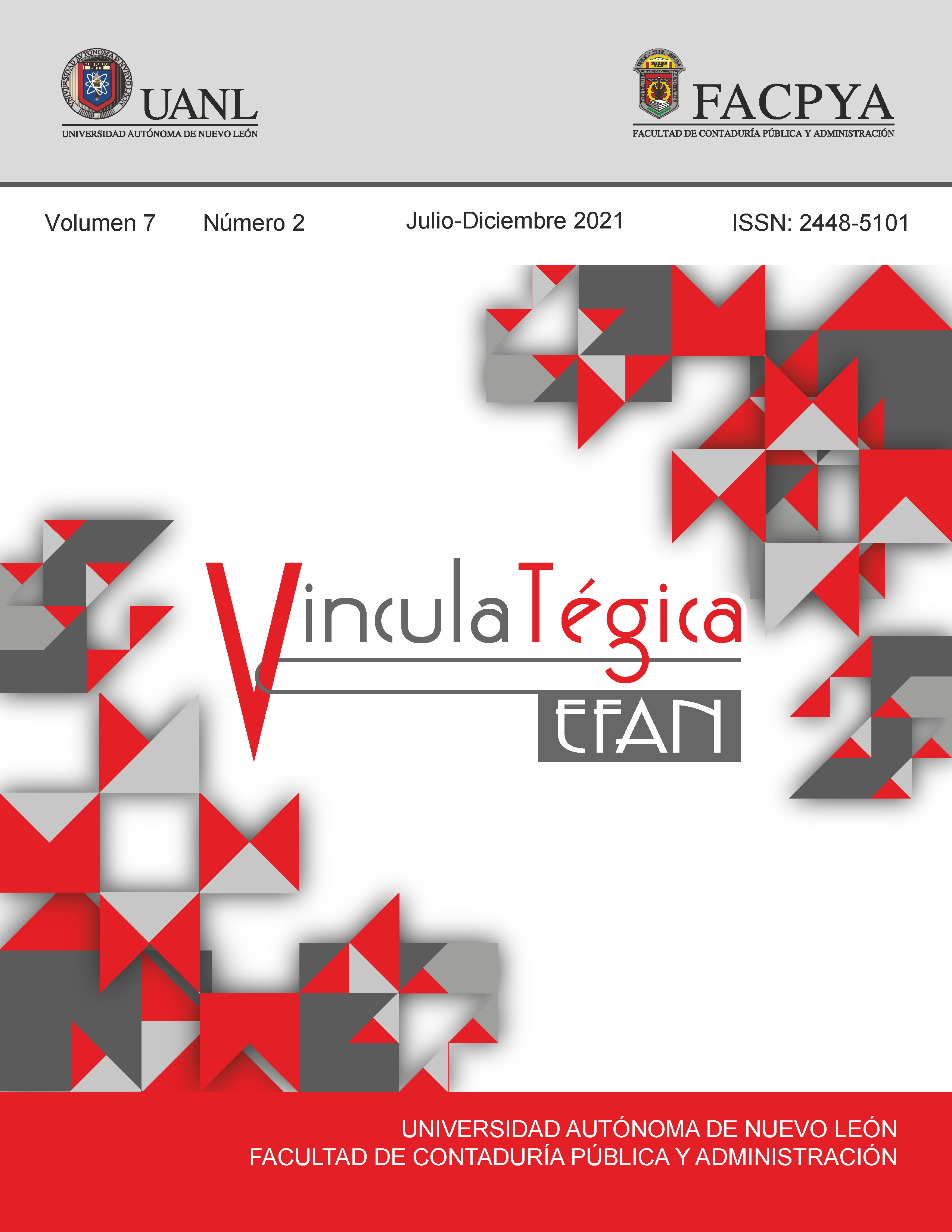Revisión sistemática de la literatura: desarrollo de proveedores, innovación y competitividad
DOI:
https://doi.org/10.29105/vtga7.1-146Palabras clave:
Cadena de suministro, Innovación, Competitividad.Resumen
En la actualidad, las empresas manufactureras se han centrado en la administración de la cadena de suministro y cómo mejorar su competitividad. Las ventajas competitivas son más fuertes si se trabaja en colaboración con los proveedores. En este contexto se analiza la importancia de investigar la relación del desarrollo de proveedores con la mejora de la capacidad competitiva a través de la innovación. El objetivo de este artículo es realizar una revisión sistemática de la literatura relacionada con el desarrollo de proveedores y la competitividad, en particular, la innovación como una ventaja competitiva en ambientes industriales o de manufactura. Los resultados se obtuvieron de artículos científicos recuperados de las bases de datos Ebsco, Scopus, Web of science y Google Académico que fueron publicados entre 2017 y 2021. Se siguió un proceso de selección con la metodología PRISMA. Los resultados demostraron que la tendencia ha ido en incremento en los últimos 5 años principalmente en países desarrollados. Se observa que México tiene una mínima participación en estas investigaciones.
Descargas
Citas
APICS. (2015, March 11). The Total Scope of Supply Chain Management. Association for Supply Chain Management. http://www.apics.org/sites/apics-blog/thinking-supply-chain-topic-search-result/thinking-supply-chain/2015/03/11/the-total-scope-of-supply-chain-management
Aura, M., & Juma, D. (2020). Influence of supplier development on operational performance of manufacturing firms in the Nairobi Securities Echange, Kenia. International Journal of Recent Research in Social Sciences and Humanities, 7(3), 88–105. https://www.paperpublications.org/upload/book/paperpdf-1599368891.pdf
Barney, J. (1991). Firm Resources and Sustained Competitive Advantage. Journal of Management, 17(1), 99–120. https://doi.org/10.1177/014920639101700108 DOI: https://doi.org/10.1177/014920639101700108
Calignano, G., & Vaaland, T. I. (2017). Supplier Development in Tanzania; Experiences, expectations and motivation. The Extractive Industries and Society, 4(2), 385–397. https://doi.org/10.1016/j.exis.2017.01.012 DOI: https://doi.org/10.1016/j.exis.2017.01.012
Chen, L., Ellis, S., & Holsapple, C. (2015). Supplier Development: A Knowledge Management Perspective. In Knowledge and Process Management (Vol. 22, Issue 4, pp. 250–269). John Wiley and Sons Ltd. https://doi.org/10.1002/kpm.1478 DOI: https://doi.org/10.1002/kpm.1478
Chen, L., Ellis, S., & Holsapple, C. (2018). A knowledge management perspective of supplier development: Evidence from supply chain scholars and consultants. Knowledge & Process Management, 25(4), 247–257. http://10.0.3.234/kpm.1566 DOI: https://doi.org/10.1002/kpm.1566
Crossan, M. M., & Apaydin, M. (2010). A Multi-Dimensional Framework of Organizational Innovation: A Systematic Review of the Literature. Journal of Management Studies, 47(6), 1154–1191. https://doi.org/10.1111/j.1467-6486.2009.00880.x DOI: https://doi.org/10.1111/j.1467-6486.2009.00880.x
Dalvi, M. V., & Kant, R. (2018). Effect of supplier development activities on performance outcomes: an empirical study. Benchmarking, 25(2), 489–516. https://doi.org/10.1108/BIJ-07-2016-0107 DOI: https://doi.org/10.1108/BIJ-07-2016-0107
Darroch, J., & McNaughton, R. (2002). Examining the link between knowledge management practices and types of innovation. Journal of Intellectual Capital, 3(3), 210–222. https://doi.org/10.1108/14691930210435570 DOI: https://doi.org/10.1108/14691930210435570
Egghe, L. (2006). An improvement of the h-index: The g-index. ISSI Newsletter, 1–4. http://pds4.egloos.com/pds/200703/08/11/g_index.pdf
Goksu, I. (2021). Bibliometric mapping of mobile learning. Telematics and Informatics, 56, 101491. https://doi.org/10.1016/j.tele.2020.101491 DOI: https://doi.org/10.1016/j.tele.2020.101491
Gunasekaran, A., Patel, C., & McGaughey, R. E. (2004). A framework for supply chain performance measurement. International Journal of Production Economics, 87(3), 333–347. https://doi.org/10.1016/j.ijpe.2003.08.003 DOI: https://doi.org/10.1016/j.ijpe.2003.08.003
Gunasekaran, Angappa, Subramanian, N., & Papadopoulos, T. (2017). Information technology for competitive advantage within logistics and supply chains: A review. Transportation Research Part E: Logistics and Transportation Review, 99, 14–33. https://doi.org/10.1016/j.tre.2016.12.008 DOI: https://doi.org/10.1016/j.tre.2016.12.008
Hamel, G. (2006). The Why , What , and How of Management Innovation. Harvard Business Review, February, 1–15. http://he-product-images.s3.amazonaws.com/docs/R0602Cf2.pdf
Heinritz, S. (1959). Purchasing: Principles and applications (Third Edit). Prentice Hall.
Hinterhuber, A., & Liozu, S. M. (2014). Is innovation in pricing your next source of competitive advantage? Business Horizons, 57(3), 413–423. https://doi.org/10.1016/j.bushor.2014.01.002 DOI: https://doi.org/10.1016/j.bushor.2014.01.002
Hirsch, J. E., & Buela-Casal, G. (2014). The meaning of the h-index. International Journal of Clinical and Health Psychology, 14(2), 161–164. https://doi.org/10.1016/S1697-2600(14)70050-X DOI: https://doi.org/10.1016/S1697-2600(14)70050-X
Holsapple, C. W., & Singh, M. (2001). Knowledge chain model: Activities for competitiveness. Expert Systems with Applications, 20(1), 77–98. https://doi.org/10.1016/S0957-4174(00)00050-6 DOI: https://doi.org/10.1016/S0957-4174(00)00050-6
Kitchenham, B. (2004). Procedures for Performing Systematic Reviews. In Procedures for Performing Systematic Reviews. https://doi.org/10.1145/3328905.3332505 DOI: https://doi.org/10.1145/3328905.3332505
Koen, P. A., Bertels, H. M. J., & Elsum, I. R. (2011). The three faces of Business model innovation: Challenges for established firms. Research Technology Management, 54(3), 52–59. https://doi.org/10.5437/08953608X5403009 DOI: https://doi.org/10.5437/08453608X5403009
Krause, D., Handfield, R., & Scannell, T. (1998). An empirical investigation of supplier development: Reactive and strategic processes. Journal of Operations Management, 17(1), 39–58. https://doi.org/10.1016/S0272-6963(98)00030-8 DOI: https://doi.org/10.1016/S0272-6963(98)00030-8
Krause, D. R., Handfield, R. B., & Tyler, B. B. (2007). The relationships between supplier development, commitment, social capital accumulation and performance improvement. Journal of Operations Management, 25(2), 528–545. https://doi.org/10.1016/j.jom.2006.05.007 DOI: https://doi.org/10.1016/j.jom.2006.05.007
Lawson, B., & Samson, D. (2001). Developing innovation capability in organisations: A dynamic capabilities approach. International Journal of Innovation Management, 05(03), 377–400. https://doi.org/10.1142/s1363919601000427 DOI: https://doi.org/10.1142/S1363919601000427
Leenders, M. (1966). Supplier Development. Journal of Purchasing, 2(4), 47–62. https://doi.org/10.1111/j.1745-493X.1966.tb00039.x DOI: https://doi.org/10.1111/j.1745-493X.1966.tb00039.x
Madhani, P. (2010). Resource Based View (RBV) of Competitive Advantage: An Overview. In Resource Based View: Concepts and practices. http://papers.ssrn.com/sol3/papers.cfm?abstract_id=1578704
Matt, C., Hess, T., & Benlian, A. (2015). Digital Transformation Strategies. Business & Information Systems Engineering, 57(5), 339–343. https://doi.org/10.1007/s12599-015-0401-5 DOI: https://doi.org/10.1007/s12599-015-0401-5
Mol, M. J., & Birkinshaw, J. (2009). The sources of management innovation: When firms introduce new management practices. Journal of Business Research, 62(12), 1269–1280. https://doi.org/10.1016/j.jbusres.2009.01.001 DOI: https://doi.org/10.1016/j.jbusres.2009.01.001
Nemlioglu, I., & Mallick, S. K. (2017). Do Managerial Practices Matter in Innovation and Firm Performance Relations? New Evidence from the UK. European Financial Management, 23(5), 1016–1061. https://doi.org/10.1111/eufm.12123 DOI: https://doi.org/10.1111/eufm.12123
O’Connor, N. G., Yang, Z., & Jiang, L. (2018). Challenges in gaining supply chain competitiveness: Supplier response strategies and determinants. Industrial Marketing Management, 72, 138–151. https://doi.org/10.1016/j.indmarman.2018.04.003 DOI: https://doi.org/10.1016/j.indmarman.2018.04.003
Page, M. J., McKenzie, J. E., Bossuyt, P. M., Boutron, I., Hoffmann, T. C., Mulrow, C. D., Shamseer, L., Tetzlaff, J. M., Akl, E. A., Brennan, S. E., Chou, R., Glanville, J., Grimshaw, J. M., Hróbjartsson, A., Lalu, M. M., Li, T., Loder, E. W., Mayo-Wilson, E., McDonald, S., … Moher, D. (2021). The PRISMA 2020 statement: an updated guideline for reporting systematic reviews. BMJ, 372, n71. https://doi.org/10.1136/bmj.n71 DOI: https://doi.org/10.1136/bmj.n71
Porter, M. E. (2007). La ventaja competitiva de las naciones. Harvard Business Review América Latina, Reimpresió, 4–23. https://es.calameo.com/read/00472423715ecda3a215b
Price, D. (1963). Little Science, Big Science. In Little Science, Big Science. Columbia University Press. https://doi.org/10.7312/pric91844 DOI: https://doi.org/10.7312/pric91844
PRISMA. (2020). Preferred Reporting Items for Systematic Reviews and Meta-Analyses. PRISMA 2020 Statement. http://prisma-statement.org/
Sulungbudi, M., Yanamandram, V., Akter, S., & Tam, L. (2019). Supplier development: Practices and measurement. In A. G. Abdullah, I. Widiaty, & C. U. Abdullah (Eds.), Global Competitiveness: Business Transformation in the Digital Era. Routledge. https://doi.org/10.1201/9780429202629 DOI: https://doi.org/10.1201/9780429202629-42
Teece, D. (2010). Business Models, Business Strategy and Innovation. Long Range Planning, 43(2–3), 172–194. https://doi.org/10.1016/j.lrp.2009.07.003 DOI: https://doi.org/10.1016/j.lrp.2009.07.003
Teece, D., Pisano, G., & Shuen, A. (1997). Dynamic capabilities and strategic management. Strategic Management Journal, 18(7), 509–533. https://doi.org/10.1142/9789812796929_0004 DOI: https://doi.org/10.1002/(SICI)1097-0266(199708)18:7<509::AID-SMJ882>3.0.CO;2-Z
Vaccaro, I. G., Jansen, J. J. P., Van Den Bosch, F. A. J., & Volberda, H. W. (2012). Management Innovation and Leadership: The Moderating Role of Organizational Size. Journal of Management Studies, 49(1), 28–51. https://doi.org/10.1111/j.1467-6486.2010.00976.x DOI: https://doi.org/10.1111/j.1467-6486.2010.00976.x
Van der Westhuizen, J., & Ntshingila, L. (2020). The effect of supplier selection, supplier development and information sharing on SME’s business performance in Sedibeng. International Journal of Economics and Finance Studies, 12(2), 153–167. https://doi.org/10.34109/ijefs.202012203
Villena, V. H., Revilla, E., & Choi, T. Y. (2011). The dark side of buyer-supplier relationships: A social capital perspective. Journal of Operations Management, 29(6), 561–576. https://doi.org/10.1016/j.jom.2010.09.001 DOI: https://doi.org/10.1016/j.jom.2010.09.001
Wagner, S., & Bode, C. (2008). An Empirical Examination of Supply Chain Performance Along Several Dimensions of Risk. Journal of Business Logistics, 29(1), 307–325. https://doi.org/10.1002/j.2158-1592.2008.tb00081.x DOI: https://doi.org/10.1002/j.2158-1592.2008.tb00081.x
Wang, C., & Ahmed, P. (2007). Dynamic capabilities: A review and research agenda. International Journal of Management Reviews, 9(1), 31–51. https://doi.org/10.1111/j.1468-2370.2007.00201.x DOI: https://doi.org/10.1111/j.1468-2370.2007.00201.x
Yang, Y., Guo, L., Zhong, Z., & Zhang, M. (2018). Selection of Technological Innovation for Service-Orientated Enterprises. Sustainability, 10(11), 1–13. https://doi.org/10.3390/su10113906 DOI: https://doi.org/10.3390/su10113906
Zhang, M., & Hartley, J. L. (2018). Guanxi, IT systems, and innovation capability: The moderating role of proactiveness. Journal of Business Research, 90, 75–86. https://doi.org/10.1016/j.jbusres.2018.04.036 DOI: https://doi.org/10.1016/j.jbusres.2018.04.036
Zhang, Y., Khan, U., Lee, S., & Salik, M. (2019). The influence of management innovation and technological innovation on organization performance. a mediating role of sustainability. Sustainability (Switzerland), 11(2). https://doi.org/10.3390/su11020495 DOI: https://doi.org/10.3390/su11020495
Descargas
Publicado
Cómo citar
Número
Sección
Licencia

Esta obra está bajo una licencia internacional Creative Commons Atribución 4.0.
Los autores que publiquen en la revista VinculaTégica EFAN aceptan el siguiente aviso de derechos de autor:
a). Los autores conservan los derechos de autor y ceden a la revista el derecho de la primera publicación de la obra bajo una licencia de atribución de Creative Commons. Esta licencia permite a otros compartir la obra siempre que se reconozca la autoría original y la publicación inicial en esta revista.
b). Los autores pueden establecer acuerdos contractuales adicionales de manera independiente para la distribución no exclusiva de la versión publicada en la revista (por ejemplo, publicarla en un repositorio o incluirla en un libro), siempre que se reconozca la publicación inicial en esta revista.
c). Se permite a los autores autoarchivar su trabajo en repositorios institucionales o en su propio sitio web antes y durante el proceso de envío, ya que esto puede fomentar intercambios productivos y aumentar la citación temprana y general del trabajo publicado.







